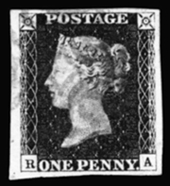
Britain starts using adhesive postage stamps, with the penny-black stamp allowing prepayment of postage at a fixed, low rate.

It used to be the recipient’s responsibility to pay postage. If delivery was refused, the Royal Mail couldn’t collect, and it lost plenty of revenue that way.
Railroads were making a rapid national mail service both possible and, because of the increased freight traffic, necessary. Reformer Rowland Hill campaigned for a cheap, pay-in-advance system that would make the mails available to everyone and help British commerce in the bargain. He proposed the rate of one penny (about forty cents in current U.S. money). Proof of payment would be either prepaid stationery or a label printed on “a bit of paper just large enough to bear the stamp, and covered at the back with a glutinous wash.” Voilà: postage stamp.
The first design featured a portrait of young Queen Victoria. All subsequent British stamps have shown the head of the reigning monarch, either as the main subject or as a smaller design motif. The stamps came in sheets of 240, the number of pence in a pound in the pre-1971 system. In 1841, the Royal Mail replaced the penny-blacks with penny-red stamps, largely because the black stamps were too easy to counterfeit. Also, the black ink hid postmarks, and people were reusing canceled stamps. Postal customers had to cut the sheets themselves, because perforations didn’t arrive until 1854.
Postal traffic doubled in the first year and quadrupled by 1850. The system spread to more than 150 countries by 1880.
Some say postage stamps originated, at least in concept, in Austria, Sweden, or maybe Greece. But British stamps are still the only ones in the world that need not name the country of origin: the monarch’s head suffices.—RA